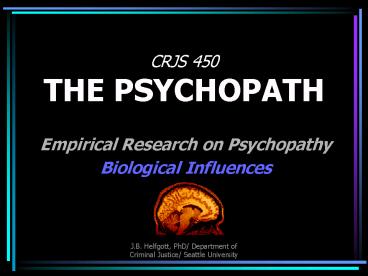CRJS 450 THE PSYCHOPATH - PowerPoint PPT Presentation
1 / 14
Title:
CRJS 450 THE PSYCHOPATH
Description:
Theories are not mutually exclusive Must be considered within an integrative framework Evidence from neuroimaging ... Implications for counseling and therapy. – PowerPoint PPT presentation
Number of Views:157
Avg rating:3.0/5.0
Title: CRJS 450 THE PSYCHOPATH
1
CRJS 450THE PSYCHOPATH
- Empirical Research on Psychopathy
- Biological Influences
2
The Biological Perspective
- Study of the biological origins of psychopathy is
founded upon the correlation between psychopathy,
crime, and aggression drawing on findings from
research on - biology and crime
- biology and aggression
- The biological perspective includes
- Neuroanatomy/Neuropsychology
- Genetics
- Neurochemistry/Neurotransmitters
- Hormones
- Autonomic Reactivity
3
Biological Origins of Psychopathy
- Research gaining the most attention in recent
years is in neuroanatomy and neuropsychology with
focus on the - Prefrontal cortex
- Orbitofrontal cortex
- Limbic System
- Amygdala
4
The Human Brain
5
Components of the Human Brain
6
Brain Imaging
- Positron Emission Tomography (PET)
- first scanning method to provide information on
brain function as well as anatomy - used in conjunction with small amounts of
radiolabeled compounds to visualize brain anatomy
and function.
- Magnetic Resonance Imaging (MRI)
- newest most versatile medical imaging technology
available - useful for imaging the brain and
spine - Produces highly refined images of the body's
interior without surgery by using strong magnets
and pulses of radio waves
7
Research by Adrian Raine
- Found that violent offenders have shrunken
prefrontal cortexes - Affective but not predatory murderers show
anomalies on PET scans
8
The Prefrontal Cortex
- Plays a role in higher cognitive functions, such
as concentration, planning, judgment, emotions,
and personality determination. - Frontal lobe is involved in motor skills
(including speech) and cognitive functions - Damage to the orbitofrontal cortex may play a
role in violent behavior with differences between
affective and predatory offenders.
9
Research by James Blair
- Dysfunction in the psychopaths brain lies in the
amygdala - Amygdala regulates FEAR and emotion -dysfunction
of Amygdala explains the psychopaths lack of
fear and empathy.
10
The Amygdala
- Part of the Limbic System located within the
temporal lobe - controls social and sexual behavior and other
emotions. - plays a critical role in processing emotion and
mediating fear.
11
Additional Findings
- Murderers
- Reduced prefrontal activity
- Poor functioning of the left angular gyrus (lies
at junction of the temporal, parietal, and
occipital regions) linked to reduced verbal
ability - Reductions in functioning of the corpus callosum
(which provides lines of communication between
left and right hemispheres) associated with
inappropriate emotional expression and inability
to comprehend long-term implications. - Psychopaths
- Inhibited startle reflex in response to
emotionally aversive stimuli. - Low autonomic arousal as measured through skin
conductivity/galvanic skin response
12
The Final Word?
- Theories are not mutually exclusive
- Must be considered within an integrative
framework - Evidence from neuroimaging studies, and
biological research findings in general, is
promising but inconclusive.
13
Treatment and Ethics
- Treatment implications of the biological
perspective? - Ethical legal Considerations particularly with
respect to the criminal justice system?
14
Recommended Reading
- Raine, A. (1993). The Psychopathology of Crime.
New York Academic Press. - Raine, A. Dunkin, J. (1990). The genetic and
psychophysiological basis of antisocial
behaviour Implications for counseling and
therapy. Journal of Counseling Development,
68, 637-644. - Raine, A. Sanmartin, J. (Eds.) (2001).
Violence and Psychopathy. New York Kluwer
Academic/Plenum Publishers.































